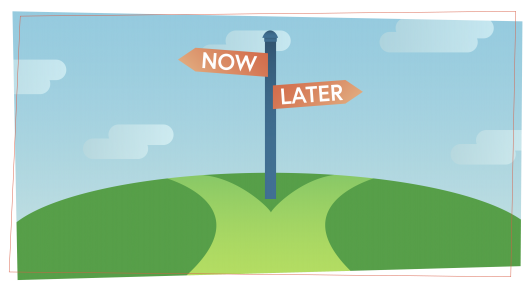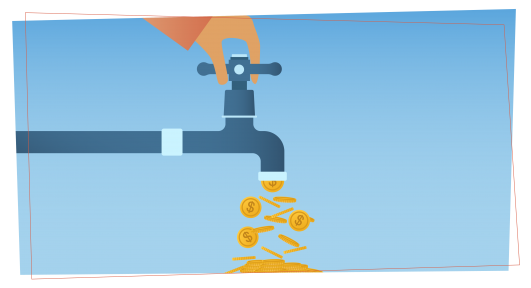Why Monitoring Cash Flow is Like Working Out
Cash Flow Basics
What are the healthiest businesses doing today that every business—no matter how small—can emulate? That’s an easy question: It’s monitoring cash flow.
Your cash flow is the lifeline of your business. In fact, 69% of small business owners report that they are losing sleep over their cash flow—or lack thereof.
The real problem with cash flow is that it’s a bit like working out. If you aren’t regularly monitoring it, your records are going to be out of date and skewed. And when you don’t have accurate accounts of your cash on hand, you put your business at risk of hemorrhaging money—and possibly shutting down completely.
But first: what is cash flow?
You may be looking at your current books and think—why does cash flow matter? I’m making a profit!
But cash flow isn’t profit. Put simply, your cash flow is the cash you have on hand to run your business. You may have enough cash saved up for a month, two months, maybe three. Or perhaps you don’t have any extra cash on hand.
Take a look at what happened with COVID-19. Thousands of businesses found themselves without a source of cash flow, meaning they had to rely on their reserves. Those who couldn’t find operating capital, from bank loans to collecting payments, folded. According to estimates from the Washington Post, the figures from March to May suggested over 100,000 businesses shut down permanently.
Understanding your cash flow is one way to prevent closure due to unexpected (and expected) events. If you aren’t reviewing it in the long-term, you won’t be prepared for future disruptions, and you certainly won’t be able to scale.
What happens if you don’t track cash flow?
Pandemics and extreme disruptions aside, there are plenty of events that can be derailed (or derail your business) if you are recording and analyzing your cash flow. Remember how we said it’s like exercising? Your business can pick up some pretty serious ailments if you’re not keeping track. On the other hand, understanding your cash flow can also open new opportunities.
This is what happened to the owner of Simple Focus, JD Graffam, who eventually purchased Pulse App. “I started trying to figure out how to calculate how much money I needed at the end of the year,” says Graffam on the Elite Entrepreneurs podcast, “I discovered not only how much I made personally, but how much I could reinvent in the business. Or even if I was in a position to buy another business.”
It’s easy enough. But cash flow is often only hastily compiled during a crisis or maybe even tax season. But when we use cash flow analysis so haphazardly, we end up wasting more time and energy. In a way, it’s a lot like exercising. Do it regularly, and the upkeep is easy. But try it only once and a while and you’re left sore and unmotivated.
Here are our top six examples of things that can go wrong if you aren’t monitoring your cash flow:
1. Overstocked and overspent
Have you ever worked out too much, but didn’t realize it because you weren’t keeping track of your schedule? Or maybe you wanted to get in shape in two weeks for a beach trip? When you exercise too much, you can end up hurting yourself. The same is true when it comes to spending.
If you haven’t been monitoring your cash flow, you may not realize how much you are spending with suppliers. Whether you have your supplier orders on an automated platform or not, you need to understand how much money is going out and how much inventory you need to move. Because the fact is, you don’t make money until you sell your stock.
2. Stretched out payment terms
Conversely, what about those of us who only workout once in a while? If you don’t exercise regularly, you aren’t getting the benefits. What about businesses that don’t collect their payments, or only do so after an extended period? Same deal.
Another issue is your payment terms. When are you getting paid? If you aren’t looking closely, you may be spreading your payment dates too far. This means that it can easily become difficult to pay a supplier or a loan if your customers miss their payment deadline.
3. Mistake profits for positive cash flow
If you’ve ever worked out at the gym, it’s easy to use one of those body trainer machines the wrong way and end up spraining something. When you mistake profits for cash flow, you’re essentially hurting yourself in the same way.
Remember when we talked about profits and cash flow not being the same thing? If you aren’t separating the two, it’s easy to mistake your operating cash for profit. This means you may accidentally overspend your operating cash and end up in a pickle when you suddenly need to buy new equipment.
4. Unplanned expenses
Working out can also keep you healthy and prevent a variety of illnesses. If you think of managing your cash flow as a preventative measure, it serves a similar purpose.
Speaking of sudden repairs, unplanned expenses may put you in a hole. If you don’t know how much cash you have on hand, you don’t have enough saved for emergencies. These expected expenses can include needing to suddenly rehire an employee, broken equipment, customer refunds, your supplier going out of business, and needing to find a replacement. All of these things can add up, and small business loans aren’t easy to get. Rather than depend on loans, you can plan ahead when you control your cash flow.
5. No control
Not exercising is basically putting your health in freefall.
The fact is, when you don’t monitor your cash flow, you have no control over where your money is going. This makes it hectic to make plans to grow your business, or even to attempt simple tasks like planning taxes. You may be leaving money on the table by not tracking all your income and expense sources, too.
6. Overall poor decision making
We’ve looked at a lot of different aspects of not taking control of your cash flow, from stretching out your cash on hand to being unable to prepare for unexpected expenses. All this boils down to one main point: If you aren’t tracking your cash flow from the beginning—if you can’t account for every cent in your business—you aren’t going to be able to make the best decisions possible. After all, you won’t have all the information in front of you.
Keeping an easy-to-read record of your finances means that you can make informed decisions not just based on your needs today, but a year ahead or more.
How we look at cash flow
When it comes to cash flow, you first need to write down all of your income streams and where you are spending your money. Your expenses don't just include office supplies and payroll, but also potential loans and taxes. Income can also involve things like dividends from stocks and the worth of your assets.
Once you list all of these, you need to lay out when each item is due or received for each month. This will help you understand how much money you really have on hand and if you need to make payment term adjustments.
Finally, it can help to look at the next 12 months to project how much cash flow you’ll have every month and at the end of the year. This won’t just make it easy to understand your finances, you’ll be able to make long-term decisions.
Spreadsheets are great for starting out, but can quickly become complicated. “My first spreadsheet was great, but it was very detailed,” says Graffam, “And when I pulled it up months later, it was like starting over. Because spreadsheets aren't made for maintenance. You either need to maintain it everyday or start over.”
Ideally, you want a program that won’t make you second guess your math or take hours of upkeep. As your business expands, you’ll find that monitoring your different sources of revenue and expenses becomes vastly more difficult. So, just as if you were weight training, make sure to adjust your tools as you scale.
Stay flexible, stay strong
Monitoring your cash flow lets you maintain flexibility while strengthening your business. If you don’t know how much money is going in and out, what actually counts as operating cash versus your profits, then you’ll have a hard time making decisions. But it doesn’t have to be that way. You can take back control of your business finances by just monitoring your cash flow.


